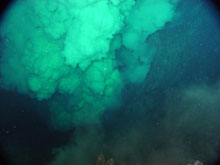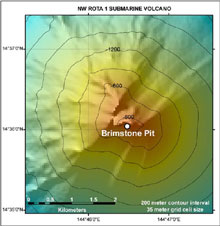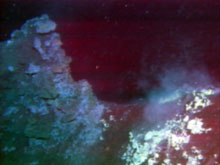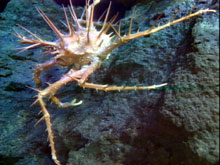
Giant smoky plume discovered pouring out of "Brimstone Pit" crater near the summit of NW Rota 1 volcano. Click image for larger view and image credit.
News Flash: Smoking 'Gun' Found at NW Rota #1 Volcano!
March 30, 2004
Bob Embley
Chief Scientist
Pacific Marine Environmental Laboratory
NOAA Vents Program
This afternoon we descended a scarp on the south side of the volcano and came onto an amazing scene of white smoke billowing out of a crater some 60 ft in diameter. Our temperature probe recorded the incredible temperature of 30° Centigrade (C) (about 22° C above the background water). The source of the fluid came from at least 10 m further down in the crater, so this represents an incredible amount of heat coming out of the sea floor. It is one of the hottest spots yet found on any submarine volcano! We're readying the next dive to return to the site later tonight, so we should have more news in a day or two. Stand by . . . and read Ed Baker's story (below) for background on the hydrothermal plume.

NW Rota 1 EM300 bathymetry. The volcano rises to a height of 535 meters below sea level. Its base is over 2000 meters deep. Brimstone Pit is near the summit of the volcano at 555 meters depth. Click image for larger view and image credit.
Plume Studies at NW Rota #1 (2003 and 2004)
Ed Baker
Supervisory Oceanographer
Pacific Marine Environmental Laboratory
NOAA Vents Program
Our first hydrothermal target on the 2004 Submarine Ring of Fire cruise was NW Rota #1, just 130 km (or about 6 hrs cruising on the R/V Thompson) north of Guam. This volcano is a Mt. Fuji-like cone rising about 2,500 m above the surrounding sea floor. In 2003, we found a 200-m-thick layer of intense hydrothermal plumes above the volcano summit. These plumes extended for at least several kilometers around the summit, indicating that a vigorous hydrothermal vent system was active. The plumes were organized into several distinct layers, suggesting that multiple vents were discharging fluids of differing temperatures.
Chemical analysis of the plumes showed that they were among the most unusual ever found above a hydrothermal source. The particles suspended in the plumes contained the highest concentration of particulate aluminum ever recorded, in addition to high concentrations of sulfur, iron, and manganese. We know these chemicals were produced by hydrothermal processes because the plumes also contained high levels of a helium isotope that is only discharged in hydrothermal systems.
This unusual chemistry indicates that at least some of the vents on NW Rota #1 are rich in sulfuric acid. Sulfur is a rich energy source for the microbes that live in hydrothermal systems. All other life in the hydrothermal ecosystems depend on these microbes, so we expect to find a rich biological community here.
We took our first CTD (conductivity, temperature, depth) measurements of the 2004 field season with a vertical cast directly over the volcano summit and a CTD tow up the southwest flank, over the summit and down the northeast flank. As all good scientists try to do, we answered some questions and found some new puzzles. We mapped intense and widespread plumes above the summit, confirming that the hydrothermal system discovered in 2003 is still vigorously active.
Unlike last year, however, we discovered an enormous cloud of suspended particles enveloping the lower slopes of the volcano like a cloud bank. This cloud extended unbroken from about 200 m below the summit (that is, about 700 m below the sea surface) to at least 1,400 m, almost halfway to the base of the volcano. Our preliminary analyses indicate that this plume is not hydrothermal, but rather debris resuspended from the slopes of the volcano. Our puzzle is this: How could such a massive resuspension occur? This cloud was not present in 2003, nor did we see such a feature on any other volcano in the Marianas. Our work here over the next few days will thus focus not only on the hydrothermal systems, but also on exploring this remarkable cloud below the summit.
Sign up for the Ocean Explorer E-mail Update List.





























